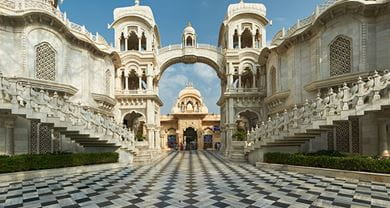- Trending:
- Easter
- |
- Lent
- |
- Forgiveness
- |
- Resurrection
- |
- Joy
- |
- Feminism

RELIGION LIBRARY
ISKCON (Hare Krishna)
Worship and Devotion in Daily Life
While the pattern differed during the first decades of the movement's history, during recent years the majority of ISKCON's members are congregation members, meaning that they live as parts of families away from temples and work in jobs unrelated to ISKCON. Although some congregational devotees visit ISKCON temples daily, most do not. Home devotional worship therefore serves as the most common form of daily devotion for Hare Krishna devotees. This excludes fulltime residents in temples, monastics, and students, for whom the rites of temple worship function as their daily worship as well.
Home devotion follows the same patterns as temple worship, though on a smaller scale. Congregational ISKCON devotees utilize a small home altar as part of their daily devotion. Some Hare Krishna members install a small statue of Krishna (or, alternatively, Krishna and his consort Radha) at the center of this altar, but the majority use easily-acquired photographs, prints, or paintings. Altars typically also include images of the ISKCON / Gaudiya Vaishnava lineage, always ISKCON founder A.C. Bhaktivedanta Swami Prabhupada and Gaudiya founder Sri Chaitanya, but generally also Bhaktvedanta's guru, Bhaktisiddhanta Saraswati Thakura, and his grand-guru, Bhaktivinoda Thakura. Hare Krishna members typically also include an image of their own spiritual master, the guru who instructed and initiated them into the movement. For the older first generation leaders this is Bhaktivedanta, but obviously this is not the case for new ISKCON converts and second-generation members.
Home devotions follow the same ritual cycle as temple worship, beginning with awakening the deities, cleaning and preparing them, feeding them, and finally putting them to sleep. Fully engaging in these rites requires a variety of ritual accoutrements, including bells, platters, incense, water, lamps, and other materials. Like temple worship, each activity requires the use of particular mantras (prayers) and calls for specific bhajans (songs) to praise Krishna. While ISKCON upholds the complete ritual cycle as an ideal, many Hare Krishna members engage in more limited worship. Even without access to the complete array of items necessary for deity worship, devotees can engage in the chanting of mantras and singing of bhajans, or songs of praise.
ISKCON has transformed eating, one of the necessary functions of human life and therefore a required daily practice for all people, into a sacred act. After preparing a meal, devotees offer a small portion of it to Krishna, making use of an image at their home altar, either a statue or a two-dimensional image. Devotees believe that the deity then consumes the essence of the food, leaving only the material matter behind as a leftover. These "leftovers," called prasadam, are highly valued as food, since they represent a shared meal with the divine. Since the devotee has prepared the entire meal as an offering, even the foodstuffs not directly placed in front of the image become prasadam, meaning that the meal becomes a sacred communion with Krishna. ISKCON members who work outside of their home often bring a small amount of prasadam with them to work, so as to enjoy communion with Krishna even when not in their home.
While deity worship and prasadam food offerings require access to an image of the divine, the practice of chanting is available at any time and place. Bhaktivedenta taught that of all religious practices, the chanting of the Hare Krishna mahamantra, "Hare Krishna, Hare Krishna, Krishna Krishna, Hare Hare, Hare Rama, Hare Rama, Rama Rama, Hare Hare," offers the best opportunity to bring about Krishna Consciousness and transcendental awareness. Bhaktivedanta's propensity to chant this mantra and that of his students in fact led to the common moniker for devotees, "Hare Krishnas," a term that most ISKCON devotees use as point of pride and self-identification.
A long history exists behind the mahamantra, including a theology of mantras that stretched back to Vedic times. Yet Hare Krishnas chant their mantra primarily because Gaudiya founder Sri Chaitanya, believed to be an appearance of Krishna, taught this as the best means of achieving God-awareness during the present age of kali yuga. Specifically, Chaitanya insisted that devotees chant the mantra aloud and publicly. Though the earliest documents do not specific which mantra Chaitanya used, the Gaudiya Vaishnava tradition suggests that it was the Hare Krishna mahamantra. Consequently, devotees understand their use of the mahamantra to stretch back to the founder of their lineage, Krishna himself made manifest.
Chanting can take many forms. Family units may chant together, or individuals may do so alone. While some devotees chant while engaging in other activities, such as driving, ideally the practice requires full concentration. Most devotees chant while sitting cross-legged or while walking. Because ISKCON devotees have sworn to chant at least sixteen rounds of mantras every day, where each round comprises one hundred and eight repetitions of the mahamantra, members of the movement spend nearly two hours every day chanting. Devotees use a string of mala (rosary) beads in order to chant japa, counting their repetitions.
While ritual activities involving deity worship and the devotional chanting of the Hare Krishna mahamantra comprise most of the daily religious activities of a Hare Krishna member, many also engage in the study of religious texts. While Bhaktivedanta clearly stated that chanting offered all the transcendental awareness a person needed, he nevertheless produced volumes of commentaries, translations, and essays, as well as gave sermons and talks that his disciples subsequently transcribed. During his lifetime, Bhaktivedanta's lectures offered the main way by which ISKCON members learned about the Gaudiya tradition. After his death in 1977, most followers turned to his written corpus to continue to learn from their spiritual master. Even as new converts, who have no immediate experience with Bhaktivedanta, join the movement his translations and commentaries serve as the central materials for study within the movement.
Study Questions:
1. How did the demographic change of ISKCON members influence daily devotion?
2. What is placed upon an ISKCON devotee's home altar?
3. How is food used as a devotional tool?
4. What is the role of chanting within ISKCON? How is it practiced?










